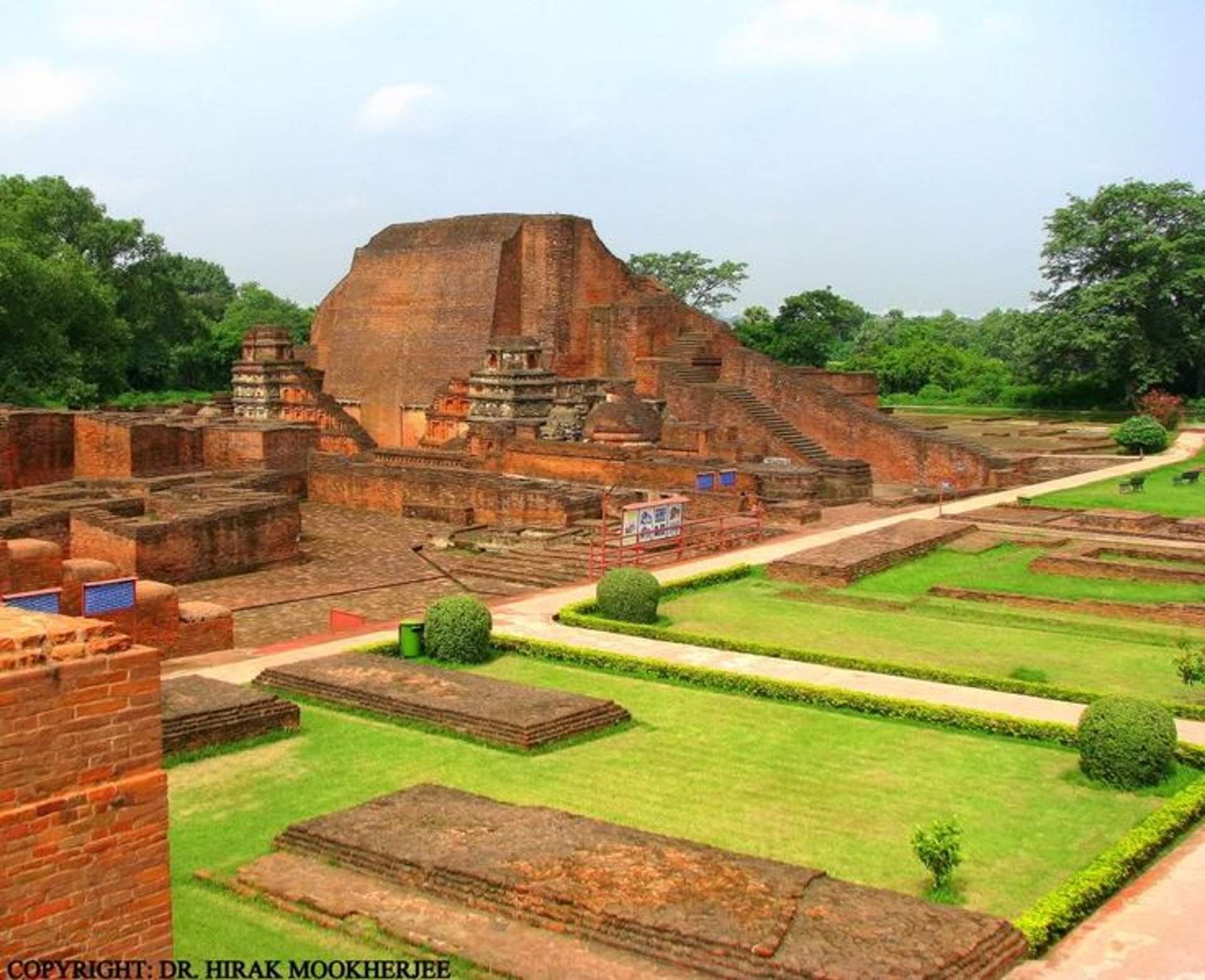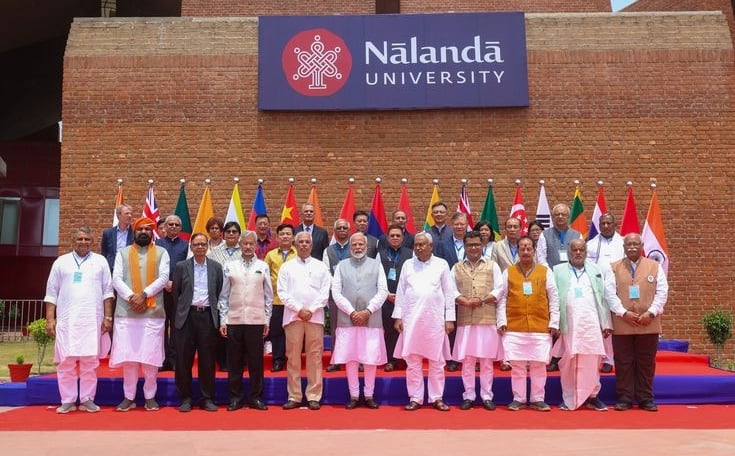
"Nalanda University: India’s Lost Seat of Wisdom"
Its tragic destruction by Bakhtiyar Khilji in the 12th century remains one of the darkest moments in history, an act of cultural and intellectual genocide that erased thousands of years of accumulated wisdom. This article delves into the history of Nalanda, its academic excellence, the great minds it nurtured, and how it was systematically destroyed by invaders who sought to undermine India’s intellectual traditions.
RELIGION
4/1/20257 min read


Nalanda University: The Lost Jewel of India's Glorious Past
Nalanda University stands as one of the greatest academic institutions in human history, a symbol of India’s intellectual supremacy before the colonial and Islamic invasions disrupted its flourishing civilization. Established in the 5th century CE, it was not merely a university but a global knowledge center that attracted scholars from across Asia. With a vast curriculum covering diverse subjects, a structured educational system, and an unparalleled repository of knowledge, Nalanda was the pride of ancient India.
Its tragic destruction by Bakhtiyar Khilji in the 12th century remains one of the darkest moments in history, an act of cultural and intellectual genocide that erased thousands of years of accumulated wisdom. This article delves into the history of Nalanda, its academic excellence, the great minds it nurtured, and how it was systematically destroyed by invaders who sought to undermine India’s intellectual traditions.
The Birth of Nalanda: A Visionary Endeavor
Nalanda University was established around 427 CE during the reign of Kumaragupta I of the Gupta Empire. The Guptas were known for their patronage of education, culture, and Hindu-Buddhist traditions, making India the epicenter of intellectual and spiritual pursuits. Located in present-day Bihar, Nalanda became the world’s first residential university, housing over 10,000 students and 2,000 teachers at its peak.
Nalanda was a meticulously planned institution. Its sprawling campus included nine-story libraries, meditation halls, temples, gardens, lecture halls, and student dormitories. Unlike modern educational institutions, which often separate learning from spirituality, Nalanda integrated education, philosophy, and ethics, fostering a culture of enlightenment and knowledge-sharing.
The university attracted not only Indian scholars but also intellectuals from China, Korea, Indonesia, Persia, and Central Asia, proving its status as a truly international center of learning.
Subjects Taught at Nalanda
Nalanda was a multidisciplinary institution where knowledge was not restricted to a single field. It offered an interdisciplinary approach, combining sciences, arts, and philosophy. Some of the prominent subjects taught included:
Buddhist Philosophy – Nalanda was one of the most advanced centers for Mahayana Buddhism, offering deep studies in Buddhist scriptures, ethics, and metaphysics.
Vedic Studies – Hindu scriptures, including the Upanishads, Vedas, and Dharma Shastras, were a crucial part of the curriculum.
Mathematics – Scholars at Nalanda developed foundational concepts in Algebra, Geometry, and Arithmetic.
Astronomy – Indian astronomers studied planetary movements, star constellations, and astrology.
Medicine (Ayurveda) – The university was a hub for Ayurvedic medicine and surgery, training students in herbal remedies and treatments.
Logic and Grammar – Rigorous training in Sanskrit grammar and logic helped scholars sharpen their analytical skills.
Art, Architecture, and Sculpture – The university played a key role in influencing temple architecture, mural paintings, and sculpture design across Asia.
Unlike today’s universities that focus solely on material success, Nalanda promoted a holistic approach, where students were encouraged to develop not only intellectual but also ethical and spiritual wisdom.
The Destruction of Nalanda University by Bakhtiyar Khilji: A Barbaric Assault on Knowledge
The destruction of Nalanda University by Bakhtiyar Khilji in 1193 CE stands as one of the most tragic and disgraceful acts in history. This barbaric invasion did not just obliterate a grand institution of learning but also symbolized the ruthless assault on Indian civilization, heritage, and intellectual progress.
Why Did Bakhtiyar Khilji Destroy Nalanda?
1. Religious Bigotry and Hatred for Knowledge: Nalanda University was a beacon of learning, with thousands of scholars studying subjects like astronomy, medicine, mathematics, logic, and Buddhist philosophy. Khilji, an Islamic invader, despised Hindu and Buddhist traditions. His goal was to wipe out indigenous knowledge, which he saw as a threat to his expansionist and religious supremacy. He wanted to eliminate the intellectual backbone of Indian civilization, ensuring that future generations would remain subjugated and ignorant.
2. Military Strategy to Crush Resistance: Khilji’s invasion of Bihar was part of a larger plan to weaken Hindu and Buddhist rulers. Nalanda was under the protection of local kings, and its scholars were well-versed in administration and strategy. By burning down the university, he sought to weaken local governance and resistance.
3. Jealousy and Insecurity: A crude and uneducated warrior, Khilji had no appreciation for knowledge. When he fell ill and was advised to seek treatment from Nalanda’s scholars, he was infuriated by their intellectual superiority. His failure to understand their medical expertise likely fueled his rage, leading him to burn down the institution in an act of sheer vengeance.
4. Loot and Plunder: Like every other barbaric invader, Khilji was also driven by greed. Nalanda had massive libraries with manuscripts written in gold ink, along with treasures accumulated over centuries. His men looted whatever they could before setting the rest on fire.
The Brutal Destruction of Nalanda
Khilji’s troops stormed Nalanda with unmatched brutality, slaughtering monks, teachers, and students. The massive libraries—containing over 9 million manuscripts—were set on fire, and the flames reportedly burned for three months. The loss was irreparable, as these manuscripts contained centuries of knowledge in various fields.
This act of cultural genocide ensured that much of India’s ancient wisdom was erased forever. Works on medicine, science, and philosophy that could have propelled human civilization forward were turned to ashes because of one man’s fanaticism and ignorance.
Criticism of Khilji: A Mindless Destroyer
Bakhtiyar Khilji deserves nothing but condemnation for his barbarity. His destruction of Nalanda was not just an attack on Buddhism but an assault on humanity itself. Unlike true warriors who conquer and build, Khilji destroyed and left nothing but devastation in his wake. His actions highlight the cowardice of a man who feared knowledge, who could not tolerate wisdom, and who wanted to plunge the land into darkness.
His name should be remembered not as a conqueror but as a disgraceful marauder—a symbol of ignorance, destruction, and religious fanaticism. The world would have been far better off without his existence.
The Intellectual Giants of Nalanda
Nalanda produced some of the world’s most renowned scholars, influencing global knowledge systems. Some of its most celebrated alumni include:
Aryabhata – One of the greatest mathematicians and astronomers of all time, Aryabhata introduced the concept of zero and the decimal system, which became fundamental to modern mathematics.
Nagarjuna – A legendary Buddhist philosopher who revolutionized Mahayana Buddhism with his Madhyamaka (Middle Path) doctrine.
Xuanzang (Hiuen Tsang) – A Chinese monk who traveled to India, studied at Nalanda for over a decade, and translated hundreds of Sanskrit Buddhist texts into Chinese.
Dharmakirti – A master of logic and epistemology, whose work influenced Buddhist and Hindu thought for centuries.
Vasubandhu – A great scholar of Yogachara Buddhism, who contributed significantly to metaphysical and psychological discussions.
The intellectual heritage of Nalanda influenced knowledge across Asia, reaching countries like China, Tibet, Japan, Korea, and Indonesia.
International Scholars Who Studied at Nalanda
Nalanda was a beacon of knowledge that attracted students and scholars from across the globe. Some of the most notable international scholars include:
Xuanzang (China) – His detailed records of Nalanda provide valuable insights into the university’s grandeur.
Yijing (China) – Another Chinese Buddhist scholar who studied and translated numerous Sanskrit texts.
Hwui Li (China) – A disciple of Xuanzang who documented Nalanda’s teachings.
Dhyānabhadra (Korea) – A Korean scholar who studied at Nalanda and spread Buddhist teachings.
Shilabhadra (Indonesia) – A prominent Buddhist teacher from Indonesia who became a head monk at Nalanda.
Kumārajīva (Kucha, Central Asia) – A revered translator who was influenced by Nalanda’s teachings.
Comparing Nalanda to Modern Education
Today’s education system pales in comparison to Nalanda in several ways:
1. Lack of Intellectual Freedom – While Nalanda encouraged free debates, modern institutions often impose ideological restrictions.
2. Commercialization of Education – Nalanda was a free institution, whereas today, education is an industry driven by profits.
3. Absence of Ethical and Spiritual Learning – Unlike Nalanda, modern universities separate education from ethics and spirituality.
4. Over-reliance on Western Education Models – Instead of preserving ancient Indic knowledge, today’s institutions prioritize Western ideologies.
Nalanda University: 8 Hidden Facts You Never Knew
1. The Underground Chamber of Lost Manuscripts
Some ancient sources and local folklore suggest that Nalanda had underground vaults to store rare manuscripts.
These chambers were believed to contain highly esoteric knowledge on advanced sciences, alchemy, and mysticism, which never resurfaced after the destruction in 1193 CE.
The British and Chinese archaeologists allegedly found traces of these hidden rooms in the 19th century, but no excavation was officially reported.
2. Nalanda May Have Been a Secret Research Center for Metallurgy
Some scholars believe that Nalanda scholars worked on advanced metallurgy and chemical sciences.
The famous rust-resistant iron pillar of Delhi (which has not corroded for over 1,600 years) is thought to be linked to knowledge preserved at Nalanda.
Manuscripts related to alchemical practices, mercury purification, and advanced alloys may have been lost after the invasion.
3. A Lost Connection Between Nalanda and Tibet
Tibetan records suggest that some Nalanda monks escaped during Bakhtiyar Khilji’s attack, carrying secret texts to remote monasteries in Tibet and Nepal.
It is believed that some parts of Nalanda’s lost wisdom, including Tantric and Vajrayana Buddhist texts, are still hidden in unexplored monasteries of Tibet.
4. The Mystery of Nalanda’s Water System
Archaeological evidence suggests that Nalanda had a complex water harvesting and drainage system, far ahead of its time.
Some historians speculate that this system may have included underground aquifers and artificially cooled chambers—a concept similar to modern air-conditioning.
5. The Chinese Involvement in Nalanda’s Revival – A Geopolitical Angle
The new Nalanda University project (started in 2010) has received significant support from China, Japan, and Singapore.
Some experts suggest that China’s deep interest in Nalanda’s revival is not just historical, but also a part of their strategy to claim Buddhist heritage influence in Asia.
6. The Forgotten Contribution of Hindu Scholars
While Nalanda is often associated with Buddhist teachings, few people know that it also had Hindu scholars teaching the Vedas, Upanishads, and Nyaya philosophy.
Some recovered manuscripts show that Shankaracharya’s followers debated Buddhist scholars at Nalanda, influencing Advaita Vedanta.
7. The Myth of Bakhtiyar Khilji’s Instant Destruction
It is commonly believed that Bakhtiyar Khilji burned Nalanda in one attack, but historical accounts suggest that the decline started long before his invasion.
Political instability, weakening patronage from Indian rulers, and internal disputes had already led to Nalanda’s gradual decline before the final attack.
8. The Ruins May Still Contain Hidden Inscriptions
Archaeologists working in Nalanda have found stone inscriptions buried under layers of ruins.
Some texts, possibly written in ancient Pali, Sanskrit, or Tibetan, are yet to be deciphered fully.
If these inscriptions are studied in-depth, they might rewrite our understanding of Nalanda’s real influence.
The Need to Revive India’s Ancient Educational Heritage
The revival of Nalanda University in 2010 is a positive step, but it lacks the grandeur and intellectual rigor of the original institution. To truly reclaim India’s academic supremacy, we must:
Integrate Indic knowledge systems with modern subjects.
Promote Sanskrit and Indian philosophy as mainstream studies.
Restore traditional gurukul education, emphasizing holistic learning.
Rebuild vast knowledge repositories like Dharmaganja.
Conclusion
Nalanda University was the crown jewel of ancient India, representing a civilization far ahead of its time. Its destruction by Islamic invaders was not just a loss for India but a loss for humanity. Today’s education system must learn from Nalanda’s model—where knowledge was sacred, education was free, and intellectual debates flourished.
India must reclaim its lost legacy and ensure that future generations know the truth about their heritage. Only by reviving the spirit of Nalanda can India once again become Vishwaguru—the world’s teacher.